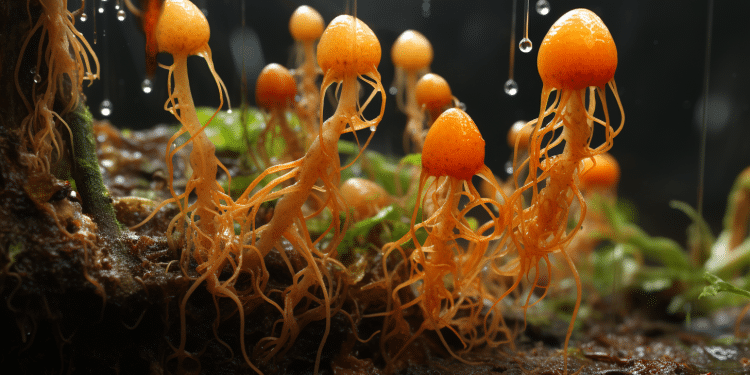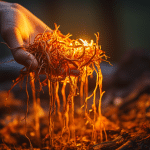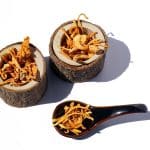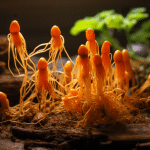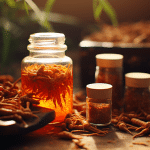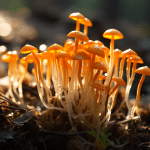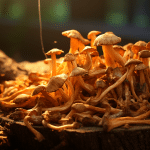In todays market, most products claiming to be cordyceps sinensis are usually not authentic. This is because those products are missing the actual cordyceps fruiting bodies and are actually using the mycelium, so they claim. The fruiting body of cordyceps looks like this:
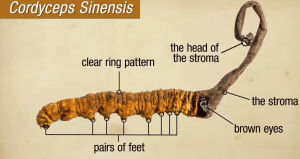
A glance at the history of cordyceps sinensis offers an intriguing history of the emergence of ancient Chinese traditional medicine in todays world.
A Brief History of Cordyceps Fruiting Body Cultivation
Ophiocordyceps sinensis is a mushroom that is often called the cordyceps. In China, it is called Dong Chong Xia Cao, translated to Winter Worm, Summer grass, while in Tibet, it is called Yartsa Gunbu. Winter worm, summer grass refers to the fact that it parasitizes and consumes the hibernating caterpillar during winter, then produces the grass-blade-like fruiting body at the end of spring.
This “caterpillar mushroom” is consumed by the caterpillars and everything else. It is usually found in soils in the grasslands in the highlands of 3,000m altitudes, Sichuan, Yunnan, Qinghai, and Tibetan provinces in China.
O. sinensis was first recorded in the 1694 China Herbal, and its usage is at least 300 years old or more. It was formally recorded in Chinas pharmacopoeia as a botanical medicine in 1964. It is one of the best-known traditional Chinese medicines and medicinal mushrooms today.
Due to its popularity and popularity, wild-harvested supplies are coming under heavy harvesting pressure, making it todays most expensive Chinese herbal remedy. National Geographic recently called it the “golden worm of Tibet”.
The wholesale price is currently up to $20,000 a kilogram.
Traditional Uses for Cordyceps Fruiting Body
According to PRCs state Pharmacopeia Commission, in 2005, O. sinensis was used to treat fatigue, cough, low sexual desire, senile weakness following serious illnesses, renal dysfunction, and renal failure. Asthenia indicates lack of energy and abnormal weakness, particularly after debilitating illnesses, and is a major area of traditional usage of cordyceps. Cordyceps is also prescribed to treat exhaustion and fatigue. Some note this use of Cordyceps is due directly to its capacity for increasing endurance and strength.
Cordyceps Fruiting Body Quality Control and Active Compounds
The quest to discover active compounds of species of cordyceps has been going on for more than 50 years. Although a range of compounds have been identified through this search which show activity, few are the only compounds which are present in sufficient quantities to show potent species-specific activity. For this reason, standards common in other fungal species were used.
Mannitol and adenosine nucleoside are two such compounds. It is now believed that polysaccharides from cordyceps constitute the most biologically active compounds because of their antioxidant, immunopotentiation, anticancer, and hypoglycemic activities.
There is also a growing body of research suggesting that Cordyceps militaris could be a major key. Cordyceps militaris also has immune modulating and anti-oxidant effects. Cordycepin occurs in enough quantities to be an actual hallmark compound of cordyceps militaris.
What We Find In Today’s Marketplace
For the longest time, nobody has been able to make mushrooms (fruit bodies) out of a culture of C. sinensis mycelium, and thus, the mycelium is now the only available, most widely used option in North America for products made with C. sinensis. Only recently, have Chinese people figured out how to grow the mushroom.
It involves growing the moth Hepialus, which is infected with Cordyceps sinensis. Then, they inoculate each moth with the mycelium of C. sinensis and incubate them under conditions that are similar to those of the Himalayas. While growing the caterpillar mushroom is now feasible, the price has yet to drop to a point where it is cost-effective for the average consumer.
Meanwhile, wild C. sinensis mushrooms (pictured above) have risen to be the worlds most expensive mushrooms. Wholesale prices are about $20,000 per kg in China.
With such high prices, there is no way that the genuine, wild-grown bodies of the C. sinensis fruit would ever make it into any sort of reasonably priced product. Despite that, most cordyceps products usually display photos of caterpillar-like mushrooms on the labels, even if they contain none.
What is Cordyceps Mycelium?
Mycelium is the vegetative body of the fungus organism, somewhat like a plants root system. It is a stage of a fungal lifecycle which collects nutrients which allow the production of the mushroom. Unfortunately, many of the products made from supposedly fungi today, including cordyceps, are made with the mycelium instead of with the mushrooms. With C. sinensis, there are two methods for making it.
Cultivation of Cordyceps Fruiting Body using Liquid Fermentation
By the 1980s, it had become apparent to the people working and using Ophiocordyceps sinensis in China that supply was not keeping pace with the demand for the mushroom. This was reinforced by ever-increasing prices on the market.
In fact, the Chinese government had designated cordyceps as a national treasure, and had instituted export restrictions, attempting to provide some stability and control over the wild harvest. Since the 1980s, numerous pure cultures claiming to be O. sinensis have been developed in China. Yet, out of all of these pure cultures, only one scholar has really demonstrated the fruiting body.
Mycelium that does not yield fruiting bodies is called anamorphous, which indicates that it is in that state as a mycelium. Numerous anamorphs have been developed, called O. sinensis, and the name anamorph is also attached as a qualifier (e.g. These anamorphs were used to make a high volume of mycelium using fermentation techniques that relied on growing the mycelium in sterile liquid media. The pure mycelium, and occasionally the liquid, was harvested, dried, and sold as an alternative to the wild-caught, very expensive O. sinensis.
It must be noted that DNA analysis showed many of these products were in fact C. militaris, rather than O. sinensis. The best known of these anamorphic products is called Cs-4.
It has been heavily analyzed in order to compare its underlying nutritional and chemical profiles with wild cordyceps. Amino acids and nucleosides were analyzed and compared.
Then, Cs-4 was put through a series of clinical trials to test whether or not it produced similar benefits and effects to wild-type cordyceps. By 1990, on the basis of the successful clinical trials, Cs-4 was certified as appropriate to be used by Chinese National Government hospitals, and was recognized as a safe and novel drug from a natural source.
If your cordyceps product is mycelium produced in China, then chances are that it is probably Cs-4 cordyceps, considered a C. sinensis strain produced using fermentation techniques, meaning that it must be 100% pure mycelium.
Cordyceps Mycelium on Grain Substrate
If the mycelium-producing product of C. sinensis is made in the United States, it is made using sterilized grains as a growing medium (a solid, not a liquid, substrate). The mycelium is grown out of the grain, and when it is ready to be harvested, the mycelium and grain substrate are then dried and milled to a powder. The problem here is that the grains are ultimately included in the end product, becoming a mix of mycelium and grains.
Tests showed that because cordyceps mycelium grows so slowly, mycelium on grains could be as high as 65 percent starch due to the remaining grains, whereas the mycelium content remains very low.
For reference, the starch content in the fruiting bodies in raw products is usually below 5%. Not only is the starch high, but the mycelium is low, and no studies based on the growth of cordyceps on grains exist. The high starch content can be easily confirmed at home with the help of a simple starch iodine test.
Authenticity of Cordyceps Sinensis Fruiting Body
The ultimate issue is the practical authenticity of Cordyceps sinensis cultures. In a recent symposium about adulteration in food products, a leading scientist at DNA sequencing lab Authen Technologies said that out of the dozens of samples of C. sinensis submitted for testing in the past 5 years, only one was authentic.
Cultivation of Genuine Cordyceps Mushrooms Fruiting Body
A recent breakthrough is the technique to grow the fruiting bodies of Cordyceps militaris, another species of cordyceps. Cordyceps militaris is grown on highly nutrient-dense substrates, in an enclosed environment with a controlled temperature and humidity. This has led to a robust supply of Cordyceps fruit bodies in the first place.
Studies of C. militaris has shown medicinal properties to be similar to those of O. sinensis, and indeed, C. militaris has been used interchangeably in Traditional Chinese medicine. This also means there is absolutely no confusion about the true identity of the mushroom, since C. militaris is easy to identify.
Companies are now empowered with an option of buying the cordyceps as a cultured form, certified by an organic certification agency, instead of as a mycelium-based product. Best of all, the prices are accessible, making it possible to utilize cordyceps at a far greater scale.
To sum up, there is not an economic market choice when it comes to the products made from the cordyceps genus. Cordyceps sinensis, the caterpillar fungus, is just impossible to offer as a cost-effective product.
Cs-4 is pure mycelium, but quality can vary among the many Cs-4 products, which are usually filled with fillers. The U.S. produces grain-based mycelium, which has no studies supporting this, which is mostly starch from leftover grains.
You can find our favorite capsules, powders, and tincture’s on the following pages of our website and learn more about each individually:
The Best Cordyceps Mushroom Gummies
Additional Resources:
Does Cordyceps Strengthen the Immune System?
Updated 10/17/2022
